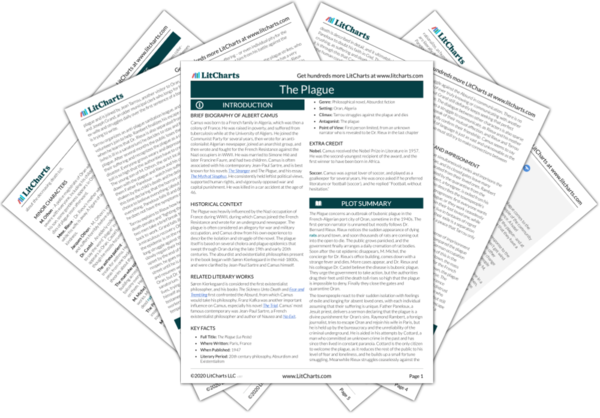Absurdism
The Plague is essentially a philosophical novel, meaning that it forwards a particular worldview through its plot and characterization. Camus is often considered an existentialist, but the philosophy he most identified with and developed was called absurdism. At its most basic, this philosophy holds that the universe is absurd and meaningless – there is no God or cosmic order – and that humans are doomed to suffer and die. Because of this situation, humans have…
read analysis of AbsurdismSuffering and Death
The rest of the themes generally follow as corollaries to Camus’ philosophy. In the novel the bubonic plague is a symbol of many things – the harsh, meaningless universe, the human condition, or war – but all of them mean suffering and death. The people of Oran deal with this meaningless suffering in various ways. At first they try to ignore or downplay it, and then they see it as a personal antagonist separating them…
read analysis of Suffering and DeathHeroism and Defiance
Despite the enormity of suffering and death in the world and the seeming omnipotence of the plague, there are instances of heroism and altruistic struggle as well. Camus immediately undercuts the “heroic” efforts of the volunteer groups by declaring that to the fight the plague is the only decent, truly human thing to do, but this is because he believes that humans are generally good. These “heroes” fit into his idea of Absurdism, as in…
read analysis of Heroism and Defiance
Language and Communication
While The Plague is a tale of absurdist philosophy, it is also a novel with living characters and a deeply human story, and Camus’ writing is potent in its imagery of suffering, despair, and courage. The chronicle’s unknown narrator eventually reveals himself as Dr. Rieux, who has been trying to take a more detached view of the plague. This is a reflection of Camus himself, who describes the calamity of Oran objectively, without romanticizing…
read analysis of Language and CommunicationExile and Imprisonment
The plague simultaneously exiles and imprisons the town of Oran, and its closed gates leave many citizens separated from their loved ones. Rambert and Rieux are both separated by the quarantine from the women they love, and Rambert, a foreigner, is exiled from his own home as well. Camus also describes the townspeople’s feelings of exile as the plague progresses: first everyone wants to speed up time and end the plague, or they work ceaselessly…
read analysis of Exile and Imprisonment






